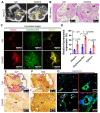Highly elastic 3D-printed gelatin/HA/placental-extract scaffolds for bone tissue engineering
- PMID: 35673575
- PMCID: PMC9169369
- DOI: 10.7150/thno.73146
Highly elastic 3D-printed gelatin/HA/placental-extract scaffolds for bone tissue engineering
Abstract
Bioengineering scaffolds have been improved to achieve efficient regeneration of various damaged tissues. In this study, we attempted to fabricate mechanically and biologically activated 3D printed scaffold in which porous gelatin/hydroxyapatite (G/H) as a matrix material provided outstanding mechanical properties with recoverable behavior, and human placental extracts (hPE) embedded in the scaffold were used as bioactive components. Methods: Various cell types (human adipose-derived stem cells; hASCs, pre-osteoblast; MC3T3-E1, human endothelial cell line; EA.hy926, and human dermal fibroblast; hDFs) were used to assess the effect of the hPE on cellular responses. High weight fraction (~ 70 wt%) of hydroxyapatite (HA) in a gelatin solution supplemented with glycerol was used for the G/H scaffold fabrication, and the scaffolds were immersed in hPE for the embedding (G/H/hPE scaffold). The osteogenic abilities of the scaffolds were investigated in cultured cells (hASCs) assaying for ALP activity and expression of osteogenic genes. For the in vivo test, the G/H and G/H/hPE scaffolds were implanted in the rat mastoid obliteration model. Results: The G/H/hPE scaffold presented unique elastic recoverable properties, which are important for efficient usage of implantable scaffolds. The effects of G/H and G/H/hPE scaffold on various in vitro cell-activities including non-toxicity, biocompatibility, and cell proliferation were investigated. The in vitro results indicated that proliferation (G/H = 351.1 ± 13.3%, G/H/hPE = 430.9 ± 8.7% at day 14) and expression of osteogenic markers (ALP: 3.4-fold, Runx2: 3.9-fold, BMP2: 1.7-fold, OPN: 2.4-fold, and OCN: 4.8-fold at day 21) of hASCs grown in the G/H/hPE scaffold were significantly enhanced compared with that in cells grown in the G/H scaffold. In addition, bone formation was also observed in an in vivo model using rat mastoid obliteration. Conclusion:In vitro and in vivo results suggested that the G/H/hPE scaffold is a potential candidate for use in bone tissue engineering.
Keywords: bone; gelatin; placental-extracts; scaffold; tissue engineering.
© The author(s).
Conflict of interest statement
Competing Interests: The authors have declared that no competing interest exists.
Figures







Similar articles
-
Characterization and Biocompatibility Assessment of 3D-Printed HA/PCL Porous Bionic Bone Scaffold: in Vitro and in Vivo Evaluation.J Musculoskelet Neuronal Interact. 2025 Mar 1;25(1):119-132. doi: 10.22540/JMNI-25-119. J Musculoskelet Neuronal Interact. 2025. PMID: 40024235 Free PMC article.
-
Fabrication of Mechanically Reinforced Gelatin/Hydroxyapatite Bio-Composite Scaffolds by Core/Shell Nozzle Printing for Bone Tissue Engineering.Int J Mol Sci. 2020 May 11;21(9):3401. doi: 10.3390/ijms21093401. Int J Mol Sci. 2020. PMID: 32403422 Free PMC article.
-
[Osteogenesis effect of dynamic mechanical loading on MC3T3-E1 cells in three-dimensional printing biomimetic composite scaffolds].Zhongguo Xiu Fu Chong Jian Wai Ke Za Zhi. 2018 Apr 15;32(4):448-456. doi: 10.7507/1002-1892.201711091. Zhongguo Xiu Fu Chong Jian Wai Ke Za Zhi. 2018. PMID: 29806303 Free PMC article. Chinese.
-
Bone tissue engineering gelatin-hydroxyapatite/graphene oxide scaffolds with the ability to release vitamin D: fabrication, characterization, and in vitro study.J Mater Sci Mater Med. 2020 Oct 31;31(11):97. doi: 10.1007/s10856-020-06430-5. J Mater Sci Mater Med. 2020. PMID: 33135110
-
Effects of 3-dimensional Bioprinting Alginate/Gelatin Hydrogel Scaffold Extract on Proliferation and Differentiation of Human Dental Pulp Stem Cells.J Endod. 2019 Jun;45(6):706-715. doi: 10.1016/j.joen.2019.03.004. Epub 2019 May 2. J Endod. 2019. PMID: 31056297
Cited by
-
Advances and Functional Integration of Hydrogel Composites as Drug Delivery Systems in Contemporary Dentistry.Gels. 2024 Oct 16;10(10):661. doi: 10.3390/gels10100661. Gels. 2024. PMID: 39451314 Free PMC article. Review.
-
3D-printed PCL framework assembling ECM-inspired multi-layer mineralized GO-Col-HAp microscaffold for in situ mandibular bone regeneration.J Transl Med. 2024 Mar 1;22(1):224. doi: 10.1186/s12967-024-05020-1. J Transl Med. 2024. PMID: 38429799 Free PMC article.
-
Tissue Regeneration with Gelatine/Polysaccharide Derived Hydrogel Scaffolds: From Formulation to In Vivo Efficacy.Gels. 2023 Sep 13;9(9):744. doi: 10.3390/gels9090744. Gels. 2023. PMID: 37754425 Free PMC article.
-
3D-printed placental-derived bioinks for skin tissue regeneration with improved angiogenesis and wound healing properties.Mater Today Bio. 2023 May 20;20:100666. doi: 10.1016/j.mtbio.2023.100666. eCollection 2023 Jun. Mater Today Bio. 2023. PMID: 37273796 Free PMC article.
-
Exploring the Osteogenic Potential of Zinc-Doped Magnesium Phosphate Cement (ZMPC): A Novel Material for Orthopedic Bone Defect Repair.Biomedicines. 2024 Feb 1;12(2):344. doi: 10.3390/biomedicines12020344. Biomedicines. 2024. PMID: 38397946 Free PMC article.
References
-
- Griffin KS, Davis KM, McKinley TO, Anglen JO, Chu T-MG, Boerckel JD. et al. Evolution of bone grafting: bone grafts and tissue engineering strategies for vascularized bone regeneration. Clin Rev Bone Miner Metab. 2015;13:232–44.
-
- Baldwin P, Li DJ, Auston DA, Mir HS, Yoon RS, Koval KJ. Autograft, allograft, and bone graft substitutes: clinical evidence and indications for use in the setting of orthopaedic trauma surgery. J Orthop Trauma. 2019;33:203–13. - PubMed
-
- Wang Z, Wang Y, Yan J, Zhang K, Lin F, Xiang L. et al. Pharmaceutical electrospinning and 3D printing scaffold design for bone regeneration. Adv Drug Deliv Rev. 2021;174:504–34. - PubMed
Publication types
MeSH terms
Substances
LinkOut - more resources
Full Text Sources
Research Materials

